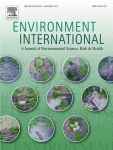Environment International 42
Overview of new articles on POPs in a new issue of the Environment International journal.

Pages 37-46
Tieyu Wang, Jong Seong Khim, Chunli Chen, Jonathan E. Naile, Yonglong Lu, Kurunthachalam Kannan, Jinsoon Park, Wei Luo, Wentao Jiao, Wenyou Hu, John P. Giesy
- Concentrations of PFOA and PFOS in rivers of Northern China were directly proportional to levels of industrialization. The highest concentrations of PFCs, PFOA and PFOS were observed in the Liaohe River system reflecting point sources. PFCs concentrations in Guanting and Hohhot were 3 to 20 fold less than those from Tianjin and Liaoning. The larger mass flows of PFOS were accompanied by relative larger magnitudes of PFOA. Concentrations of both PFOA and PFOS in waters from all regions were less than those suggested allowable values.
Pages 47-52
Bo Deng, JianQing Zhang, Lishi Zhang, YouSheng Jiang, Jian Zhou, Daokui Fang, Huiming Zhang, HaiYan Huang
- This is the first study on PCDD/Fs and PCBs levels in human breast milk in the city of Shenzhen (China). he body burden and EDI were higher than those in non-exposed areas in mainland China.The body burden was higher than that in some underdeveloped countries. Inhabitation period and fish consumption were positively correlated with the body burden.Continuous surveillance on PCDD/Fs and PCBs levels in human milk is needed.
Pages 53-58
Ruifang Fan, Dongli Wang, Chuanwei Mao, Shangkang Ou, Zhixia Lian, Shaoling Huang, Qiongshan Lin, Runhao Ding, Jianwen She
- The children's urinary PAH metabolite (OH-PAHs) level were explored in Guangzhou and their associations with 8-OHdG. The elementary school children from the polluted area had higher urinary levels of 2-OHN, 2-OHF, 2-, 3-, 4-OHPhe and 1-OHP than those from the control group. The results suggested that heavy traffic pollution led to higher PAH body burden.
Perfluorinated compounds in seafood from coastal areas in China
Pages 67-71
Yongning Wu, Yuxin Wang, Jingguang Li, Yunfeng Zhao, Feifei Guo, Jiaying Liu, Zongwei Cai
- The first nationwide investigation on PFCs in seafood from China was conducted. A Preliminary estimation on dietary intake of PFCs from seafood was obtained in China. The varied status of PFCs in fatty fish and shellfish were found in various sea areas. The results of risk assessment indicated low risk for PFCs intake from seafoods in China.
Pages 72-77
Shengtao Ma, Zhiqiang Yu, Xiaolan Zhang, Guofa Ren, Ping'an Peng, Guoying Sheng, Jiamo Fu
- Levels and congener profiles of PBDEs reported in breast milk from Shanghai, China. Higher brominated from octa- to deca-BDEs accounted for more than 70% of total PBDEs. Air inhalation and dust ingestion might be the major exposure routes. Further study should focus on health risk assessment of higher brominated BDEs.
Pages 84-90
Haitao Shen, Gangqiang Ding, Yongning Wu, Guoshao Pan, Xiaoping Zhou, Jianlong Han, Jingguang Li, Sheng Wen
- We reported levels of PCDD/Fs, PCBs and PBDEs in 74 breast milk from general population in Zhejiang province, China. We compared finger prints of these pollutants between human samples and foodstuffs. Similar PCDD/F and PCB patterns were found between human samples and foodstuffs, which implies dietary intake is the main route for human exposure to POPs. Other passway, like inhalation, may explain the difference patterns of PBDE between human samples and foodstuffs.
Pages 124-131
Ying-Xin Yu, Yu-Ping Pang, Chen Li, Jun-Ling Li, Xin-Yu Zhang, Zhi-Qiang Yu, Jia-Liang Feng, Ming-Hong Wu, Guo-Ying Sheng, Jia-Mo Fu
- Seasonal variations of PBDE concentrations in in-/out-house dust were observed. The lowest PBDE concentrations in in-/out-house dust were found in the autumn. PBDE bioaccessibility/concentrations significantly correlated with organic matter. PBDE daily intake corrected with bioaccessibility was lower than most estimates.
Determination of polybrominated diphenyl ethers in human semen
Pages 132-137
Peng-Yan Liu, Ya-Xian Zhao, Yi-Yang Zhu, Zhan-Fen Qin, Xian-Li Ruan, Yong-Chuan Zhang, Bao-Jun Chen, Yan Li, Shi-Shuai Yan, Xiao-Fei Qin, Shan Fu, Xiao-Bai Xu
- PBDEs were found for the first time in human semen samples from Taizhou, China. The ∑PBDEs level in semen was about two times lower than in human blood. A correlation of ∑PBDEs concentration was found between in paired semen and blood. Data showede low brominated congeners could be more easily transferred to semen.
Pages 138-143
Guanyong Su, Xiaohua Liu, Zishen Gao, Qimin Xian, Jianfang Feng, Xiaowei Zhang, John P. Giesy, Si Wei, Hongling Liu, Hongxia Yu
- We determined total concentrations of 14 PBDEs and 28 PCBs in 137 samples of fish and meat from Nanjing. The PBDEs’ concentrations were less than those reported from other countries in fishes, but were relatively higher than other countires in meat. Current exposures of common people to 28 PCBs in Nanjing was estimated to be 0.82pgPCBTEQWHO/kg bw.
20.3.2012




